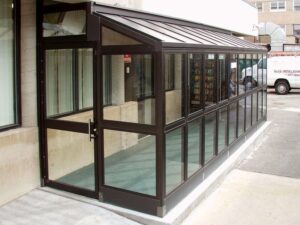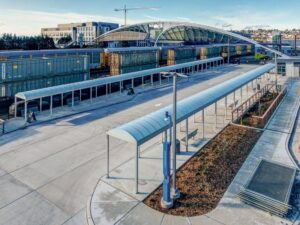How Covered Walkways Improve Safety and Accessibility for Businesses
Rainstorms don’t wait for shift changes. Snow doesn’t accommodate accessibility needs. Blazing sun doesn’t care about your visitors’ comfort. But well-designed walkway covers do.
Covered walkways are strategic infrastructure elements that directly impact user safety, comfort, and mobility. From bustling healthcare campuses and transit hubs to sprawling corporate and institutional facilities, these structures play a vital role in shaping how people experience and move through public and private spaces.
As demand for resilient and user-focused infrastructure grows, covered walkways are increasingly seen not just as optional enhancements, but as critical components of accessible and sustainable site design.
Protecting People from the Elements—Year-Round
A primary benefit of walkway covers is their ability to protect pedestrians from harsh or unpredictable weather. Rain, snow, and ice turn exposed walkways into hazards, especially for older adults, children, and individuals using mobility aids. Covered walkways act as a shield, keeping footpaths dry and reducing the risk of slips and falls—an important safety consideration for facilities with high foot traffic.
Protection from extreme heat is another growing concern. In regions experiencing increasingly hot summers, exposed surfaces and direct sun can pose health risks. Covered walkways help regulate exposure and keep pedestrians more comfortable during travel between buildings or from parking lots and bus stops to entry points.
The advantages also extend to employees, delivery personnel, maintenance crews, and emergency responders—anyone who needs to move efficiently between facilities regardless of the weather.

Photo by Handi-Hut
Supporting Universal Design and Compliance Goals
Covered walkways play a key role in achieving accessibility goals and complying with the Americans with Disabilities Act (ADA). By providing a weather-protected, stable path of travel, these structures help create a more inclusive and predictable environment for individuals with disabilities.
In practical terms, that means making sure that everyone—from wheelchair users and people with visual impairments to parents with strollers—has safe, uninterrupted access across your site. Walkway covers can be installed over ramps, at grade changes, or along long corridors, helping facilities meet both compliance standards and broader universal design goals.
Accessibility doesn’t happen by accident. It’s the result of intentional infrastructure planning—and walkway covers are a clear expression of that intent.
Streamlining Foot Traffic and Campus Navigation
Walkway covers aren’t just about weather—they’re also about flow. In large or complex environments, they serve as visual and physical connectors, guiding users along designated routes and simplifying navigation. This is especially helpful in settings with multiple buildings, such as universities, medical centers, or government campuses, where it’s easy for visitors or new employees to lose their way.
By establishing clearly marked and protected routes, covered walkways help reduce confusion and minimize the need for additional signage or staff assistance. They also encourage more people to walk between destinations, supporting healthy movement and reducing congestion at vehicular access points.
Even in compact sites, covered walkways can add meaningful value by linking parking areas to entryways or connecting outdoor break areas to indoor facilities—creating a more cohesive and intuitive user experience.
Enhancing Operational Efficiency
Beyond pedestrian comfort, walkway covers improve overall site efficiency. For instance, when employees can move between departments or buildings without getting soaked in a downpour, operations run more smoothly. In transit environments, these structures help maintain tight schedules by ensuring that riders can move quickly and safely between platforms and terminals—even in adverse conditions.
They also reduce the need for reactive maintenance. Dry, covered walkways require less frequent cleaning, and they help keep dirt, debris, and moisture from being tracked indoors. Over time, that translates to lower janitorial costs, less wear on interior surfaces, and fewer chemical treatments needed to keep public spaces clean and dry.
Facilities teams also benefit from lower outdoor maintenance costs. When snow and ice are kept off walkways, there’s less need for de-icing chemicals and snow removal services—reducing both labor hours and environmental impact.
Strengthening Public Perception and Environmental Goals
Walkway covers contribute to a facility’s identity. When users arrive at a site with clean, thoughtfully designed infrastructure, they notice. It signals a commitment to safety, accessibility, and user experience—all qualities that reflect positively on an organization’s values.
This is especially important for public-facing institutions like hospitals, universities, and government buildings, where first impressions can influence trust and satisfaction.

Photo by Handi-Hut
In addition to aesthetics, covered walkways support long-term environmental sustainability. When built with recyclable materials like aluminum and designed for durability, these structures have a minimal ecological footprint. They can be part of a broader green building strategy that includes features like low-maintenance landscaping, energy-efficient lighting, and solar-powered amenities like mobile device chargers.
They also reduce reliance on salt and chemical de-icers, which can damage vegetation, corrode infrastructure, and contaminate water runoff.
Designed for Seamless Integration
Modern walkway covers are anything but one-size-fits-all. Today’s options include a wide variety of profiles, finishes, and modular configurations that can complement any architectural style. Whether blending into a historic district or standing out in a sleek corporate campus, these structures can be tailored to match the visual identity and functional needs of a site.
Designers and specifiers can also integrate covered walkways with other infrastructure, such as transit shelters, smoking shelters, or bike shelters, creating a cohesive, weather-protected environment across an entire facility.
This level of modularity also allows for future expansion. As sites grow or change, covered walkways can be extended or reconfigured to maintain continuity and meet evolving needs without costly redesigns.
Why Handi-Hut is the Industry’s Trusted Shelter Provider
At Handi-Hut, we build covered walkways that are engineered for real-world conditions—designed to handle heavy usage, tough climates, and site-specific challenges. With decades of experience serving public and private sector clients across North America, we’ve developed a proven approach to manufacturing shelter solutions that combine long-term durability with customizable design.
Our covered walkways are constructed from rust-proof aluminum and come in a variety of finishes, lengths, and roof profiles. They’re designed to integrate seamlessly with our other weather protection solutions, ensuring a unified look and functionality across your site.
Because our products are prefabricated, they also install quickly—minimizing disruption to your operations and accelerating your path to a safer, more efficient facility. Contact us today to learn more about our customizable walkway covers.
